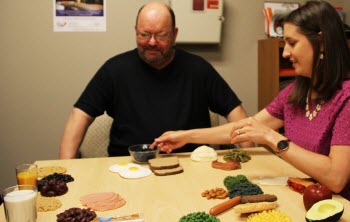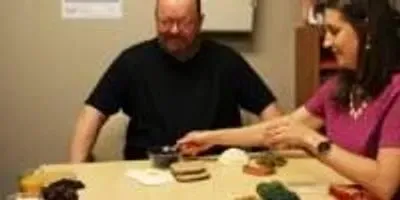Video courtesy of The Ohio State University Wexner Medical Center
 Photo courtesy of The Ohio State University Wexner Medical CenterCOLUMBUS, Ohio – Do a quick online search and you’ll find thousands of diets, tips, products, and tricks claiming to lower your blood sugar, or even ‘cure’ diabetes. A diabetes dietitian at The Ohio State University Wexner Medical Center says she’s heard them all.
Photo courtesy of The Ohio State University Wexner Medical CenterCOLUMBUS, Ohio – Do a quick online search and you’ll find thousands of diets, tips, products, and tricks claiming to lower your blood sugar, or even ‘cure’ diabetes. A diabetes dietitian at The Ohio State University Wexner Medical Center says she’s heard them all.
“Living with diabetes is challenging, and we’re human, we want an easy fix that works for us. But there’s a lot of misguided advice,” said Elizabeth Snyder, a registered dietitian and certified diabetes educator at Ohio State Wexner Medical Center. “While some of it is harmless, other things such as supplements could be harmful because we can’t guarantee what’s in them.”
Snyder explains the five most common misconceptions she hears when it comes to eating with diabetes:
‘Now I can’t eat carbs.’ People with diabetes often think they must give up carbohydrates, but Snyder says it’s not true. Carbs are an important source of energy for the body and one of the best sources of fiber. She says it’s the type of carbohydrate that makes a difference.
“Simple carbohydrates such as white bread, juice and candy send blood sugar levels on a roller coaster ride and make it hard to manage the disease. However, complex carbohydrates such as whole grain bread, beans or a potato with its skin have fiber that helps keep blood sugar levels even until the next meal,” Snyder said.
‘Eating gluten-free prevents/cures diabetes.’ Snyder says there is no evidence to support this. Gluten is a protein that provides elasticity and volume in baked goods, so gluten-free foods are actually denser and, therefore, have more carbohydrates per serving.
‘Green vegetables will lower blood sugar.’ While they are healthy foods, Snyder says green vegetables such as broccoli, green beans, lettuce, etc. won’t bring down blood sugar on their own. There’s often something else happening.
“As we investigate into those stories, we often find the patient went for a walk after dinner, or they mowed the lawn, or did something else active. It was the added activity that helped their blood sugar, not necessarily the food by itself,” Snyder said.
‘Sugar-free foods won’t raise blood sugar.’ The ice cream container might say ‘sugar-free’ but that doesn’t mean carbohydrate-free.
“Those food packages are very attractive, but they don’t tell the whole story. You have to turn them over and know what to look for,” Snyder said. “The two most important things are serving size and total carbohydrate.”
‘I can cleanse away diabetes.’ From citrus and celery root to drinking vinegar, Snyder says she’s heard about dozens of cleanses that claim to lower blood sugar or get rid of diabetes.
“Are these home remedies harmful? Probably not, but we know they’re not the healthiest choice for your body. You can’t do this one piece and not do the other good things to manage your diabetes,” Snyder said.
So, what does work?
 Photo courtesy of The Ohio State University Wexner Medical Center “The bottom line is there’s no magic cure. The first thing I tell people is the advice I’m giving you is the same advice I’d give to your twin who didn’t have diabetes. Have a balanced plate at every meal: lean protein, a non-starchy vegetable, and a carbohydrate like fruit or whole grains,” Snyder said. “And don’t skip meals. When you skip meals, your body has to work harder. Once you finally eat, it’s often so much that your body can’t use all of the carbohydrates and has to store it.”
Photo courtesy of The Ohio State University Wexner Medical Center “The bottom line is there’s no magic cure. The first thing I tell people is the advice I’m giving you is the same advice I’d give to your twin who didn’t have diabetes. Have a balanced plate at every meal: lean protein, a non-starchy vegetable, and a carbohydrate like fruit or whole grains,” Snyder said. “And don’t skip meals. When you skip meals, your body has to work harder. Once you finally eat, it’s often so much that your body can’t use all of the carbohydrates and has to store it.”It’s advice that 59-year-old Jim Meoak of Westerville, Ohio, has taken to heart. When he was first diagnosed with diabetes four years ago, he found out he needed help navigating all of the information available.
“Like everybody else, I searched online to find out what to do. You know, there’s a lot of ‘use this diet’ or ‘take these pills’ and so on out there,” Meoak said. “Then the dietitian explained everything to me—what’s good, what’s bad, what you have to look for, and it really helped me see that it’s a lifestyle change and you have to be regimented about it.”
Snyder says if you want additional online resources for diabetes advice, choose well-established sites with solid, up-to-date and scientific medical advice such as the American Diabetes Association or the National Institute of Diabetes and Digestive and Kidney Diseases.









